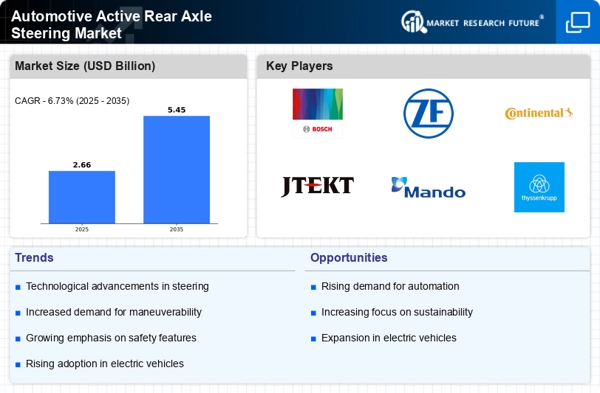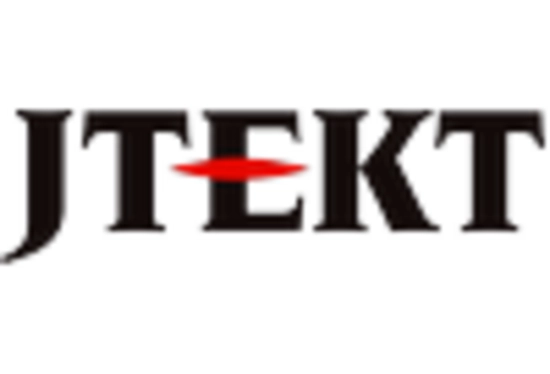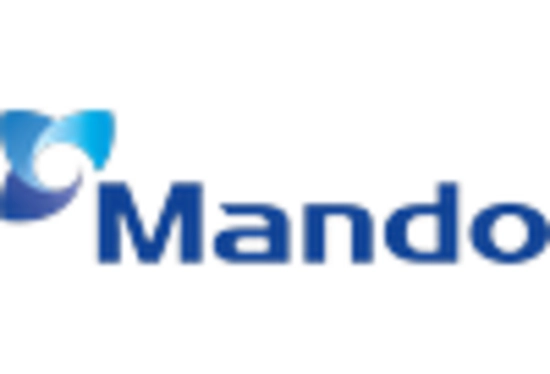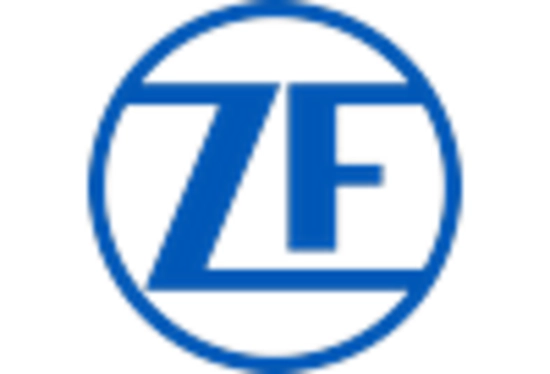The Automotive Active Rear Axle Steering Market is currently characterized by a dynamic competitive landscape, driven by technological advancements and increasing consumer demand for enhanced vehicle maneuverability and safety. Key players such as Bosch (Germany), ZF Friedrichshafen (Germany), and Continental (Germany) are at the forefront, each adopting distinct strategies to solidify their market positions. Bosch (Germany) emphasizes innovation in steering technology, focusing on integrating advanced sensors and software to enhance vehicle responsiveness. ZF Friedrichshafen (Germany) is pursuing strategic partnerships with automotive manufacturers to co-develop next-generation steering systems, thereby expanding its market reach. Meanwhile, Continental (Germany) is investing heavily in digital transformation initiatives, aiming to leverage data analytics for improved product offerings and customer engagement. Collectively, these strategies contribute to a competitive environment that is increasingly focused on technological differentiation and collaborative innovation.
In terms of business tactics, companies are localizing manufacturing to reduce costs and enhance supply chain efficiency. This approach is particularly evident in regions with burgeoning automotive markets, where local production can mitigate tariffs and logistical challenges. The market structure appears moderately fragmented, with several players vying for market share, yet the influence of major companies remains substantial. Their collective actions shape industry standards and drive technological advancements, creating a competitive atmosphere that encourages continuous improvement and innovation.
In August 2025, Bosch (Germany) announced the launch of its latest active rear axle steering system, which incorporates AI-driven algorithms to optimize steering response based on real-time driving conditions. This strategic move not only reinforces Bosch's commitment to innovation but also positions the company as a leader in the integration of artificial intelligence within automotive systems. The introduction of such advanced technology is likely to enhance vehicle safety and performance, appealing to manufacturers seeking to differentiate their offerings in a crowded market.
In September 2025, ZF Friedrichshafen (Germany) entered into a collaboration with a leading electric vehicle manufacturer to develop a bespoke rear axle steering system tailored for electric vehicles. This partnership underscores ZF's strategic focus on the growing electric vehicle segment, allowing it to leverage its expertise in steering technology while addressing the unique requirements of electric drivetrains. Such collaborations are indicative of a broader trend where traditional automotive suppliers are aligning with emerging market leaders to stay relevant in a rapidly evolving landscape.
In July 2025, Continental (Germany) unveiled a new digital platform designed to enhance the connectivity of its active rear axle steering systems. This platform aims to provide real-time data analytics to vehicle manufacturers, enabling them to optimize performance and maintenance schedules. By investing in digital solutions, Continental is not only enhancing its product offerings but also positioning itself as a key player in the digital transformation of the automotive industry, which is increasingly reliant on data-driven insights.
As of October 2025, the competitive trends within the Automotive Active Rear Axle Steering Market are heavily influenced by digitalization, sustainability, and the integration of artificial intelligence. Strategic alliances are becoming more prevalent, as companies recognize the need to pool resources and expertise to navigate the complexities of modern automotive engineering. Looking ahead, it is anticipated that competitive differentiation will increasingly pivot from traditional price-based strategies to a focus on innovation, technological advancement, and supply chain reliability, as companies strive to meet the evolving demands of consumers and regulatory standards.

















Leave a Comment